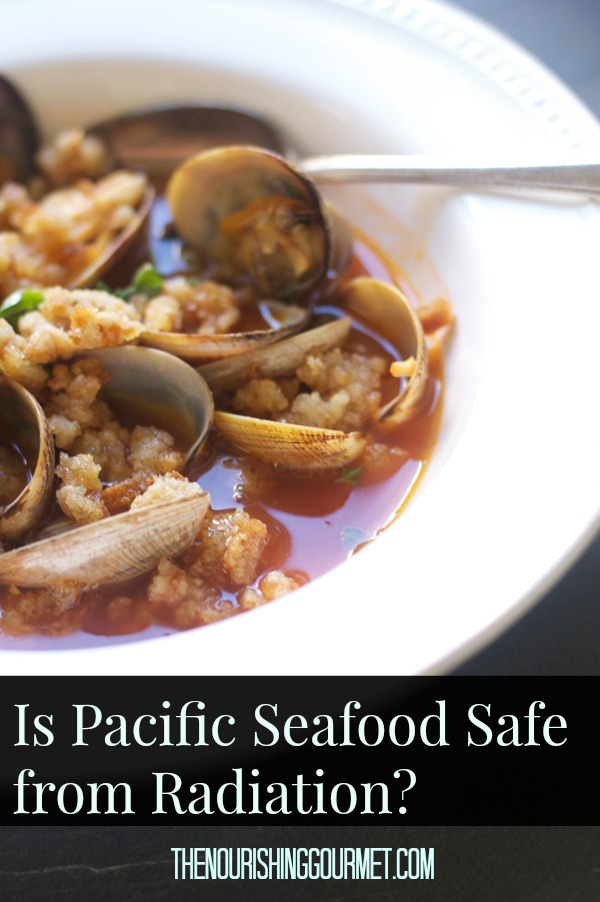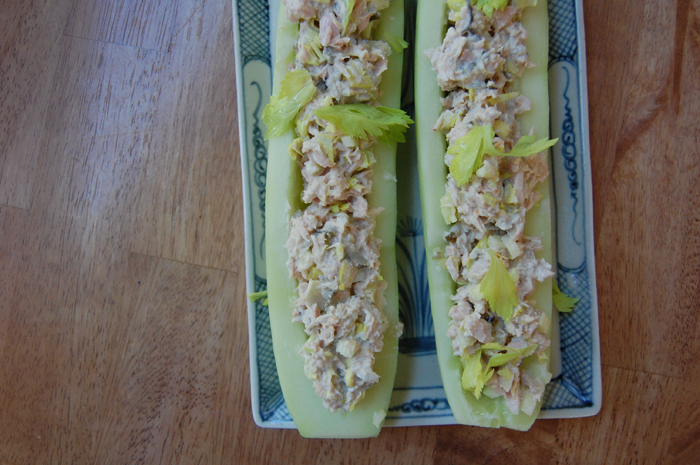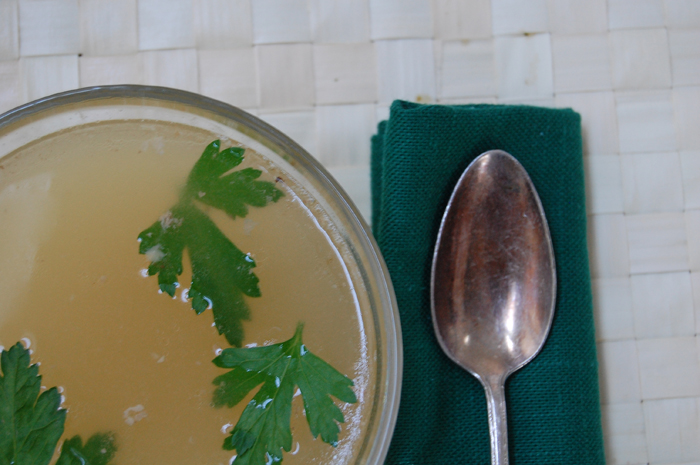
Ever since the horrible emergency in Japan, there has been a lot of turmoil over whether Pacific seafood is currently – or in the future going to be – contaminated with radiation from Fukushima. There are a lot of opinions on this subject, and I’ve read myself in circles over it ever since this disaster. While clearly those living close to Fukushima in Japan are by far those with the most concerns, I think it’s a valid question for us to consider what – if any – effect Fukushima could have on us through our environment and/or food.
Because seafood is an important part of a healthy diet according to a traditional, Dr. Price inspired viewpoint, I am loath to cut out this important food unless absolutely necessary.
I don’t feel comfortable giving you a pat answer to this complicated question, but I thought I would share some of the different opinions and information I came across in the hopes that it would help you be more informed. There is so much information out there (and a lot of wild opinions and speculations too), I’m not going to be able to cover everything, but please feel free to add your opinions and other links to the comment section. And don’t miss my resources for Atlantic seafood (for those who remain concerned about Pacific seafood) coming soon.
First, I want to primarily deal with the issue of eating Pacific seafood, however here is a brief overview of different information on radiation in our general environment. For those of us on the West Coast of the U.S., there has been a concern with how much radiation could be falling on us through the air and in our rainwater. I was reading a children’s book to my two girls recently that explained that dust particles from Japan will reach the U.S. in one week, a rather grim reminder of how connected we are to each other – even across a wide ocean.
Negative news on radiation levels on the West Coast
So I guess it’s no surprise that according to this study “ Just days after the meltdowns, I-131 [radioactive iodine] concentrations in US precipitation was measured up to 211 times above normal” and “Highest levels of I-131 and airborne gross beta [radioactive particles] were documented in the five US States on the Pacific Ocean.” This study linked this rise to congenital hypothyroid cases that rose 28% shortly after the disaster.
To further this discouraging vein (especially for those, like me, who live on the West Coast), an article published in 2012 (written by some experts on radiation issues) gave us this information on the short-term impact of Fukushima,
“How much radiation entered the U.S. environment? A July 2011 journal article by officials at Pacific Northwest National Lab in Eastern Washington state measured airborne radioactive Xenon-133 up to 40,000 times greater than normal in the weeks following the fallout. Xenon-133 is a gas that travels rapidly and does not enter the body but signals that other, more dangerous types of radioactive chemicals will follow.
A February 2012 journal article by the U.S. Geological Survey looked at radioactive Iodine-131 that entered soil from rainfall, and found levels hundreds of times above normal in places like Portland, Ore., Fresno, Calif., and Denver, Colo. The same places also had the highest levels of Cesium-134 and Cesium-137 in the U.S. While elevated radiation levels were found in all parts of the country, it appears that the West Coast and Rocky Mountain states received the greatest amounts of Fukushima fallout.
On Dec. 19, 2011, we announced the publication of the first peer-reviewed scientific journal article examining potential health risks after Fukushima. In the 14-week period March 20-June 25, 2011, there was an increase in deaths reported to the Centers for Disease Control by 122 U.S. cities. If final statistics – not available until late 2014 – confirm this trend, about 14,000 “excess” deaths occurred among Americans in this period.
We made no statement that only Fukushima fallout caused these patterns. But we found some red flags: Infants had the greatest excess – infants are most susceptible to radiation – and a similar increase occurred in the U.S. in the months following Chernobyl. Our study reinforced Fukushima health hazard concerns, and we hope to spur others to engage in research on both short-term and long-term effects.”
Positive news about radiation on the West Coast
That’s pretty depressing news, as reported closer to the actual disaster! On the other side of things, however, both the FDA and grassroots radiation monitoring seem to agree that there aren’t currently (or for the last couple of years been) abnormal radiation levels. The grassroots network is made up of people around the world who have invested in proper radiation meter equipment who turn in their readings. You can follow their map for hourly updates.
On the EPA website you can check out the nearest radiation monitor near your address, which is pretty cool, and see a graph of radiation levels. According to the Oregon state government, there hasn’t been a significant increase in radiation levels.
And this is a nice transition into our main topic – radiation and Pacific seafood – while there had been a small increase in radiation in seaweed near the California coast two years ago, those levels, as reported in January of this year, have been dropping ever since.
Why there is concern about radiation from Fukshima
There is good reason to have concern about our sea life and environment. It’s also important to weigh the evidence in deciding what seafood we eat from the Pacific Ocean. Why is there concern? Since the disaster, 300 tons of radioactive water has flowed into the ocean everyday. That’s a problem. But how much of a problem?
Good news about radiation in seafood on the West Coast
Independent results confirm low or no radiation
Let’s start with the good news this time. First, many fisheries, responding to this concern, have sent seafood samples into independent labs to test for radioactive content. Vital Choices (an Alaskan fishery) has so far found none.
Another company dealing with the customers’ fears about radiation in seafood sent samples to labs with reassuring results.
“It sent seven samples of salmon caught in Southeast Alaska and Puget Sound to a laboratory in Louisiana, at a cost of $1,200. The company released the reports in January and posted the results on its website.
What did it find? Five samples did not register any level of radiation. Two showed very low traces—well below any limits set by the government and consistent with background levels of radiation in common foods, says Knutson.”
FDA testing confirms no need for concern
An FDA update in March 2014 says that our food supply (including seafood) remains safe, and we don’t need to alter our eating habits because of Fukushima.
Even at its worst, radiation levels are very low (bananas could be worse than fish!)
Chris Kresser, a well-respected practitioner of integrative medicine in the real food world, shared his views on this issue in a podcast. He was able to put into perspective the fears of radiation in fish. He put it so well, I wanted to share an excerpt from the transcript.
“There was one large review in the Proceedings of the National Academy of Sciences, PNAS, the journal, and it evaluated the health risk of consuming Pacific Bluefin tuna that was caught in the Pacific after the Fukushima event around San Diego, I believe is where the fish were caught were for this study. And the study was done by some researchers from the Woods Hole Oceanographic Institution and a couple other organizations around the world, and they’re all independent researchers. There were no conflicts of interest, nobody that was working for the fish lobby! And let me just highlight a few of the findings for you. They estimated that a typical restaurant-sized portion of Pacific Bluefin tuna that was contaminated with radioactive isotopes cesium-134 and cesium-137 contains about 5% of the radiation you’d get from eating one uncontaminated banana and absorbing its naturally occurring radiation.
The really important thing to remember here is that all foods contain radiation because there’s radiation that’s just naturally a part of our planet. Bananas contain much more radiation in them, despite not being contaminated by Fukushima fallout, than a restaurant-sized portion, a 7-ounce portion, of fish. So, the issue is not whether we’re exposed to radiation, because we are, all of us, on a daily basis exposed to radiation in food, just walking around. If we go on a cross-country flight, we’re exposed to radiation. Like every other toxin, the question is what’s the dose? A small amount of toxin we can handle. A large amount of toxin causes problems. That’s really important to keep in mind with this. It is true that cesium-134 and cesium-137, which are these radioactive isotopes, have been found in fish because of Fukushima, but the levels are so low that they’re not going to cause any health problems, even in people who are eating fish at extremely high levels. For example, if you ate three-quarters of a pound a day of this contaminated Bluefin tuna for an entire year, you’d still receive only 12% of the dose of radiation you’re exposed to during a single cross-country flight from LA to New York. That should put it into perspective a little bit. Also, at that same level of consumption, the excess relative risk of fatal cancers would only be two additional cases per 10 million similarly exposed people, and that’s such a low number that in statistics and health there’s really reason to believe that’s no more than chance. And, in fact, statistically significant elevations in cancer risk are only observed typically at doses of radiation that are 25,000 times higher than what you’d expect to be exposed to by eating the three-quarters of a pound a day of Bluefin tuna.”
Bad news about radiation and seafood
That’s the good news. What about the bad news? Here are a couple things to consider.
Certain currents are bringing more radiated water to U.S. coasts now (this started late 2013). While many scientists say the radiated water will be too diluted by the time it reaches us, others disagree. It’s an unknown situation.
Another concern is that different radioactive material is now being leaked from the plant – some of which lasts much, much longer and is considered by some to be even more dangerous.
There is more concern with certain fish that travel extensively, namely tuna and salmon (in 2012 tuna was found to contain elevated radiation levels). Because of the wide traveling habits of these fish, they are more at risk to contain higher amounts of radiation. While the more conservative voices say that there is little to worry about, the more concerned voices point out how unprecedented this situation is, and how little we know for sure. Because of that, there continues to be a push for more testing by the FDA, as well as pro bono testing by a variety of universities and concerned scientists. Because the situation is hardly stable or contained in Japan at this point, the far-reaching future effects of the situation are still unknown, although most research to date is reassuring.
My personal conclusion
Overall, I find that there is a general agreement of reassuring research for those of us in the U.S. But I remain concerned enough to continue to keep track of new information as it comes. For those who simply no longer feel comfortable eating Pacific seafood, I’d like to give you a couple of resources for Atlantic seafood in another post soon to be published. So stay tuned for that!


